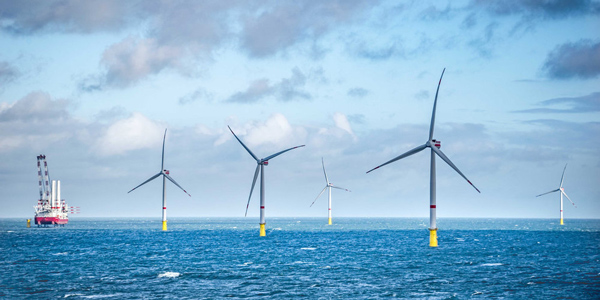An estimated 20,000 to 30,000 MW of offshore wind capacity representing a $28 billion to $57 billion investment in the U.S. economy will be operational by 2030, according to the U.S. Offshore Wind Power Economic Impact Assessment.
OSW project development, construction and operations could bring a projected 83,000 jobs in that time and deliver $12.5 billion to $25.4 billion per year in economic output. During a panel at the American Wind Energy Association’s Offshore Windpower Virtual Summit on Wednesday, state officials from Massachusetts, New Jersey, New York and Rhode Island discussed their role in training tens of thousands of people for those jobs as part of that hoped for economic boon.
Kirsten Holland, program manager for offshore wind for the Massachusetts Clean Energy Center (CEC), said a “well trained and highly skilled workforce” is needed for OSW jobs where educational requirements range from apprenticeships to advanced degrees. Holland’s agency released an assessment in 2018 examining the workforce needs and economic impact associated with 1,600 MW of OSW development.
“It really laid the groundwork for our workforce development initiatives by demonstrating that there are thousands of jobs and hundreds of millions to billions of dollars in economic impact associated with just 1,600 MW of offshore wind built out,” Holland said.
Building on that initial assessment, Holland said the CEC maintains a website dedicated to training and educational programs for clean energy jobs, including OSW, which lays out career pathways, educational offerings and training programs. Additionally, Holland said there is an active process to identify unemployed or underemployed people to set up those “who need the jobs most” with education and technical training programs.
According to Holland, another priority area was increasing access to OSW jobs, specifically those in the commercial fishing industry. She said $2 million in grant funding to 15 institutions, including a public university, community colleges and other organizations, have helped build a bridge to new employment opportunities and training over the last two years.
Laura Hastings, deputy director of the Rhode Island Department of Labor and Training’s Real Jobs program, said her state offers the Wind Win RI certification program for high school students looking to work in the OSW industry. The state also offers two free years of tuition at a community college for a renewable energy program, and there is a partnership with the Business Network for Offshore Wind to train companies that want to work in the industry. (See Tiny RI Seeks its Share of Offshore Wind Jobs.)
Earn and Learn
Matthew Vestal, senior adviser for large-scale renewables at the New York State Energy Research and Development Authority, noted his state’s legislative mandate to install 9 GW of offshore wind by 2035. By his “fairly conservative estimate,” that could mean 10,000 jobs and the capacity to provide enough renewable energy to power 6 million homes and produce 30% of the state’s electricity load.
“We recognize that offshore wind is a very unique economic opportunity,” Vestal said.
Vestal said New York is spending $20 million to create the Offshore Wind Training Institute at the Farmingdale State College and Stony Brook University campuses and additionally providing grant funds for the Center of Excellence for Offshore Energy at SUNY Maritime College. The developers of the Sunrise Wind project will spend $10 million on the Offshore Wind Training Center at Suffolk County Community College. (See related story, Preparing the Wind Energy Workforce.)
Brian Sabina, senior vice president of economic transformation at the New Jersey Economic Development Authority, said Gov. Phil Murphy wants to expand opportunities for good-paying OSW jobs through “on-ramps and off-ramps” so that people can “earn and learn at the same time,” especially people of color and women.
“We’ve more than doubled participation in apprenticeship programs by Black, Latinx and female apprentices,” Sabina said.
One area where apprenticeships are needed is welding, a skilled trade that Sabina said has leveled off in New Jersey. That is where increased regional cooperation comes into play, according to Hastings.
“Welding is robust in Rhode Island and Connecticut, as we can build nuclear submarines, largely with welders, so that’s one way we can use regionalization to play on each other’s strengths versus what we don’t have,” Hastings said.
“There’s definitely the opportunity for direct or indirect collaboration on workforce training,” Vestal added. “I think there’s the ability to send workers to different states to make this a regional workforce rather than a state-by-state workforce.”
For students in either high school or college considering the OSW industry, Hastings said that critical-thinking and problem-solving skills are in-demand attributes, aside from education and training initiatives.
“Being able to look at something critically and come up with a new solution that doesn’t exist yet, this industry is ripe for that, and if that’s the kind of person and kind of thought process that you go through, that would only help you,” Hastings said.






